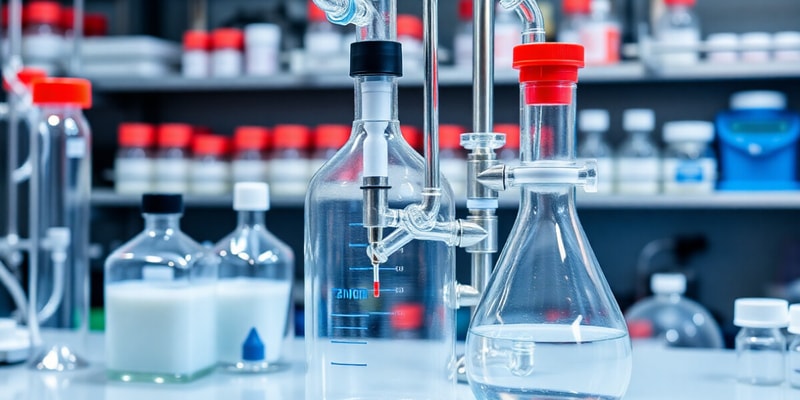Podcast
Questions and Answers
What occurs when a system reaches dynamic equilibrium in the context of chemical reactions?
What occurs when a system reaches dynamic equilibrium in the context of chemical reactions?
In the law of mass action, what do the symbols a, b, c, and d represent?
In the law of mass action, what do the symbols a, b, c, and d represent?
What is indicated by the equilibrium constant (Keq) in relation to a chemical reaction?
What is indicated by the equilibrium constant (Keq) in relation to a chemical reaction?
Which statement accurately describes a pharmaceutical process involving a drug partitioned between two phases?
Which statement accurately describes a pharmaceutical process involving a drug partitioned between two phases?
Signup and view all the answers
What defines the dynamic nature of equilibrium in a chemical system?
What defines the dynamic nature of equilibrium in a chemical system?
Signup and view all the answers
Which of the following describes a system of immiscible liquids in terms of component partitioning?
Which of the following describes a system of immiscible liquids in terms of component partitioning?
Signup and view all the answers
What is a characteristic feature of systems that are governed by the law of mass action?
What is a characteristic feature of systems that are governed by the law of mass action?
Signup and view all the answers
If substances A and B react to form C and D, and the reaction reaches equilibrium, what can be inferred about the concentrations?
If substances A and B react to form C and D, and the reaction reaches equilibrium, what can be inferred about the concentrations?
Signup and view all the answers
What role do excipients play in pharmaceutical formulations?
What role do excipients play in pharmaceutical formulations?
Signup and view all the answers
Which of the following accurately defines an Active Pharmaceutical Ingredient (API)?
Which of the following accurately defines an Active Pharmaceutical Ingredient (API)?
Signup and view all the answers
What does the first law of thermodynamics primarily relate to in pharmaceutical systems?
What does the first law of thermodynamics primarily relate to in pharmaceutical systems?
Signup and view all the answers
In the context of the second law of thermodynamics, what is entropy?
In the context of the second law of thermodynamics, what is entropy?
Signup and view all the answers
How is the phase diagram useful in understanding pharmaceutical formulations?
How is the phase diagram useful in understanding pharmaceutical formulations?
Signup and view all the answers
What is the significance of the Henderson-Hasselbalch equation in pharmacology?
What is the significance of the Henderson-Hasselbalch equation in pharmacology?
Signup and view all the answers
What does the term 'chemical potential' refer to in physical chemistry?
What does the term 'chemical potential' refer to in physical chemistry?
Signup and view all the answers
In a system exhibiting multiple solid phases, which phenomenon is most relevant?
In a system exhibiting multiple solid phases, which phenomenon is most relevant?
Signup and view all the answers
How does activity differ from concentration in the context of ionic strength?
How does activity differ from concentration in the context of ionic strength?
Signup and view all the answers
What is the primary importance of understanding eutectic points in drug formulation?
What is the primary importance of understanding eutectic points in drug formulation?
Signup and view all the answers
Which textbook is considered an intermediate level resource for understanding the science of dosage form design?
Which textbook is considered an intermediate level resource for understanding the science of dosage form design?
Signup and view all the answers
What defines a 'system' in thermodynamics as it relates to pharmaceuticals?
What defines a 'system' in thermodynamics as it relates to pharmaceuticals?
Signup and view all the answers
Which of the following best describes a 'phase' in a pharmaceutical context?
Which of the following best describes a 'phase' in a pharmaceutical context?
Signup and view all the answers
What role do equilibrium processes play in pharmacology?
What role do equilibrium processes play in pharmacology?
Signup and view all the answers
Which process would NOT typically be governed by thermodynamics in pharmaceutical contexts?
Which process would NOT typically be governed by thermodynamics in pharmaceutical contexts?
Signup and view all the answers
In thermodynamics, how is 'surroundings' best defined?
In thermodynamics, how is 'surroundings' best defined?
Signup and view all the answers
Which analytical technique is utilized to measure partitioning between phases in pharmaceuticals?
Which analytical technique is utilized to measure partitioning between phases in pharmaceuticals?
Signup and view all the answers
Which of the following statements regarding equilibrium constants is accurate?
Which of the following statements regarding equilibrium constants is accurate?
Signup and view all the answers
What is the primary focus of thermal analysis in pharmaceutical studies?
What is the primary focus of thermal analysis in pharmaceutical studies?
Signup and view all the answers
Which of the following is NOT a component of a dosage formulation in pharmaceuticals?
Which of the following is NOT a component of a dosage formulation in pharmaceuticals?
Signup and view all the answers
Which statement correctly depicts a dosage formulation?
Which statement correctly depicts a dosage formulation?
Signup and view all the answers
What does the equilibrium constant (Keq) quantify in a biochemical reaction?
What does the equilibrium constant (Keq) quantify in a biochemical reaction?
Signup and view all the answers
Given an initial concentration of G3P at 0.05 M and an equilibrium concentration of 0.002 M, what is the concentration of DHAP at equilibrium?
Given an initial concentration of G3P at 0.05 M and an equilibrium concentration of 0.002 M, what is the concentration of DHAP at equilibrium?
Signup and view all the answers
If the equilibrium constant (Keq) for the isomerisation of glucose-6-phosphate to fructose-6-phosphate is 0.428, what is the implication for the concentrations at equilibrium?
If the equilibrium constant (Keq) for the isomerisation of glucose-6-phosphate to fructose-6-phosphate is 0.428, what is the implication for the concentrations at equilibrium?
Signup and view all the answers
What is the log P value typically used to describe in chemical reactions?
What is the log P value typically used to describe in chemical reactions?
Signup and view all the answers
Which of the following correctly represents the equilibrium expression for the reaction involving G3P and DHAP?
Which of the following correctly represents the equilibrium expression for the reaction involving G3P and DHAP?
Signup and view all the answers
What is a significant issue to consider regarding pharmaceutical systems?
What is a significant issue to consider regarding pharmaceutical systems?
Signup and view all the answers
How does the equilibrium constant change for the reverse of a chemical reaction?
How does the equilibrium constant change for the reverse of a chemical reaction?
Signup and view all the answers
At 25°C, with an initial concentration of G6P at 0.1 M, how would one calculate the concentration of F6P at equilibrium based on the Keq?
At 25°C, with an initial concentration of G6P at 0.1 M, how would one calculate the concentration of F6P at equilibrium based on the Keq?
Signup and view all the answers
What unit is commonly used for expressing the concentration in biochemical reactions?
What unit is commonly used for expressing the concentration in biochemical reactions?
Signup and view all the answers
In the context of pharmaceutical systems, what role do excipients play?
In the context of pharmaceutical systems, what role do excipients play?
Signup and view all the answers
Study Notes
Introduction to Pharmaceutical Systems
- This course introduces the physicochemical principles of pharmaceutical systems.
- Pharmaceutical systems include formulations of APIs and excipients, drugs binding to receptors, enzymes binding substrates, and cellular structures.
- Physicochemical principles encompass aspects of chemistry, physics, and physical chemistry that influence the structure, stability, and function of pharmaceutical systems.
Textbook Recommendations
-
Entry-level:
- Any 3rd level general chemistry textbook (e.g., 'Chemistry' by C.E. Housecroft & E.C. Constable)
- 'Principles and problems in physical chemistry for biochemists' by Price & Dwek
-
Intermediate:
- 'Pharmaceutics; The Science of Dosage Form Design' by Aulton (Ed.)
-
Advanced:
- 'Physical Pharmacy and Pharmaceutical Science' by Martin
- 'Physical Chemistry' by Atkins & de Paula
Course Topics
- Introduction to thermodynamics: equilibrium, ideal gases
- First law of thermodynamics: enthalpy, thermochemistry
- Second law of thermodynamics: entropy, free energy
- Free energy and equilibrium
- Chemical potential, the phase rule
- Phase diagrams, triple and critical points
- Systems of one, two, three components, eutectic points, triangular phase diagrams
- Systems with multiple solid phases; polymorphs and solvates
- Acids & bases; pH, pKa; Henderson-Hasselbalch equations
- Activity and ionic strength
Thermodynamics and Pharmaceuticals
- A dosage formulation (medicine) is a system of multiple phases and components governed by thermodynamics and process equilibria.
- System: Defined part of the physical world under study.
- Phase: Homogeneous portion of physical material bounded by interfaces.
- Component: Chemical 'ingredient' of the system.
-
Examples of equilibrium processes:
- Binding of drugs to receptors or enzymes
- Biochemical reactions in body metabolism
- Processes for manufacturing APIs
- Many formulation processes
- Most measures of pharmacological activity are, effectively, equilibrium constants.
Pharmaceutical Analysis
- Pharmaceutical analysis relies on quantitative measurement of partitioning between phases using techniques like chromatography (gas chromatography, TLC, HPLC) or enthalpy (heat) transfers (Thermal Analysis), along with other quantitative physical effects.
System and Surroundings
- System: Defined part of the physical world under study
- Surroundings: Rest of the physical world (or at least that part affected by changes to the system)
- Examples: A dosage form (tablet, suspension), a reaction in a vessel, a biochemical system.
Equilibrium
- Pharmaceutical systems can consist of many components and phases (e.g., components: API, excipients; phases: solid phase, immiscible liquids, gaseous phases)
- Components may be partitioned between various phases.
- The system (phases & components) exists in dynamic equilibrium.
Law of Mass Action and Equilibrium Constants
- This law describes the dynamic equilibrium of chemical reactions.
- Equilibrium constant (Keq): A measure of the relative amounts of reactants and products at equilibrium.
- The Keq value reflects the relative tendency of a reaction to proceed in the forward or reverse direction.
Examples of Equilibrium Processes
-
Drug partitioning:
- Drugs can partition between an aqueous medium (e.g., cell interior) and a lipid medium (e.g., cell membrane).
- A partition coefficient (P) describes the equilibrium distribution of a drug between these phases, often expressed as log P.
-
Reaction equilibria:
- Chemical reactions in pharmaceutical processes reach equilibrium, with a Keq value for each reaction.
- The Keq value for the reverse reaction is the inverse of the Keq value for the forward reaction.
Biochemical Equilibrium
- The equilibrium constant (Keq) for a biochemical reaction reflects the relative concentrations of reactants and products at equilibrium.
- An example is the isomerisation of G3P to DHAP (involving an isomerase enzyme).
Structure and Stability of Pharmaceutical Systems
- Key issue: structure and stability of pharmaceutical systems, including medicines, ligands & receptors, enzymes & substrates/inhibitors.
- These systems are composed of chemical components (APIs, excipients, biomolecules) and phases (solids, liquids, gases, etc.).
- Structure and stability dictate the function and effectiveness of these pharmaceutical systems.
Studying That Suits You
Use AI to generate personalized quizzes and flashcards to suit your learning preferences.
Related Documents
Description
Explore the physicochemical principles that underlie pharmaceutical systems, including formulations of active pharmaceutical ingredients (APIs) and excipients. This course covers the interactions between drugs and biological components, focusing on the chemistry and physics involved. Prepare to delve into critical concepts like thermodynamics and the stability of pharmaceuticals.




